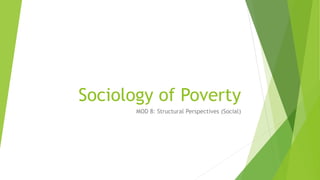
Module 8 ppt (social)
- 1. Sociology of Poverty MOD 8: Structural Perspectives (Social)
- 2. Groups Matter “Our social connections have significant economic consequences” (Royce, 2015, p. 173) We are connected to groups via ascribed and achieved statuses Ascribed: race, ethnicity, gender, etc. Achieved: book clubs, recreational sports, church, professional associations, etc.
- 3. Three Major Social Factors Group memberships Neighborhood effects Social networks “While social location certainly matters, it determines who is susceptible to poverty; it does not explain why there is poverty at all or why poverty exists to the extent it does” (p. 193)
- 4. Group Memberships Group affiliations “affect both who we are and how we live our lives” (p. 175) Groups help to reflect our identities (who we are and our beliefs, values, attitudes, etc.) Groups help determine our life chances or our access to the means to better our lives The memberships theory explains that “peer group effects, adult role models effects, and labor market connections” greatly affect individuals’ likelihood to live in poverty or experience inequality first-hand (p. 176)
- 5. Privileged Position “Groups vary in the status and prestige,” with some groups afforded more greater privilege than others (i.e., men compared to women, whites compared to non-whites, rich compared to poor, education compared to uneducated, etc.) “As a result of normal psychological processes,” individuals are “inclined to perceive people who look, talk, and live the way they do as more intelligent, competent, and worthy than people who are different” (p. 177)
- 6. Neighborhood Effects Neighborhood effects “refers to the influence of neighborhood conditions on life outcomes” such as: “Social and cognitive development, physical and mental health, school readiness and performance, educational attainment, sexual behavior and fertility, family formation, delinquency and crime, and for adults, employment and earnings” (p. 180). Neighborhood differ mainly in terms of class and race The highest-poverty neighborhoods are comprised of African-Americans and Latinos Class differences produce drastic differences (e.g., South Bronx compared to affluent CT suburbs) “Because of neighborhood inequalities, poor families are often stuck with inferior schools, inadequate public facilities, and an unhealthy and sometimes dangerous residential environment” (p. 179)
- 7. Institutional Resources Examples of these community resources: schools, libraries, recreational centers, stores, hospitals, transportation services, etc. The poor need these resources the most, yet have the least access to them Functions of these key resources include: Play a significant role during socialization Provide safe place for childhood activities Provide essential services Lead to psychological, cultural, and human capital Can create political awareness and solidarity
- 8. Labor Market Conditions William Julius Wilson explained that in the 1970s and 1980s “structural economic changes” hit poor urban communities especially hard. Examples: Shift from good-producing to service-producing work Increase gaps between low-wage and high-wage job sectors Technological innovations Relocation of manufacturing out of inner cities
- 9. Additional Factors Related to Neighborhood Effects Collective socialization Community influences from adult neighbors, peer groups, role models, etc. who provide negative norms and values – encouraging negative behaviors and reinforcing poverty Social disorganization Related to “collective efficacy,” which is seen through neighbors’ experience of frequent interaction, social ties, and shared norms (p. 182) The poor experience weak informal social control and low levels of collective efficacy
- 10. Social Networks & Social Capital Social networks: patterns of “recurrent interpersonal relationships” (p. 183) Social functions include: Channel information and convey cultural messages Create social connections Define expectations for behavior and enforce social norms Creates mutual trust and social support Allows for use of power and influence Networks create social capital: “benefits people derive from their personal interactions and social relations” (p. 184) People can have resource-rich connections or resource-poor networks
- 11. Key Social Network Characteristics Research finds that people with weak social networks and limited social capital are vulnerable to poverty and find it difficult to escape The following characteristics make a difference: Size of social networks (poor have few interpersonal connections) Social isolation (limited access to high levels of social mobility) Difficulty in mobilizing social networks (poor find it hard to make use of social connections) Preponderance of strong ties (poor have great strong ties than productive weak ties) Reliance on disposable ties (poor need to get by day-to-day) Homogeneous social networks (the power of weak social ties are great if they are diverse, which the poor have limited access to) Lack of productive social capital (hard for the poor to turn their social capital into other forms of capital) Preponderance of social support ties (poor have access to social support, not social leverage) Negative social capital (poor are more likely to be exposed to deviant norms and feel pressure of social support and loyalty)